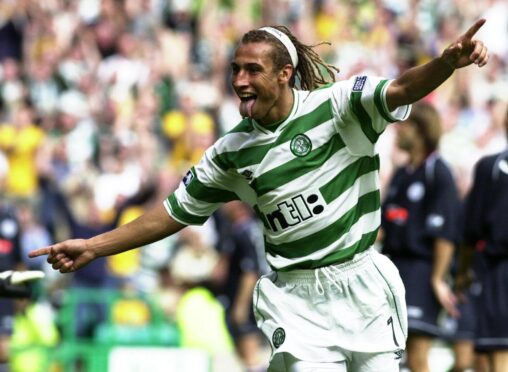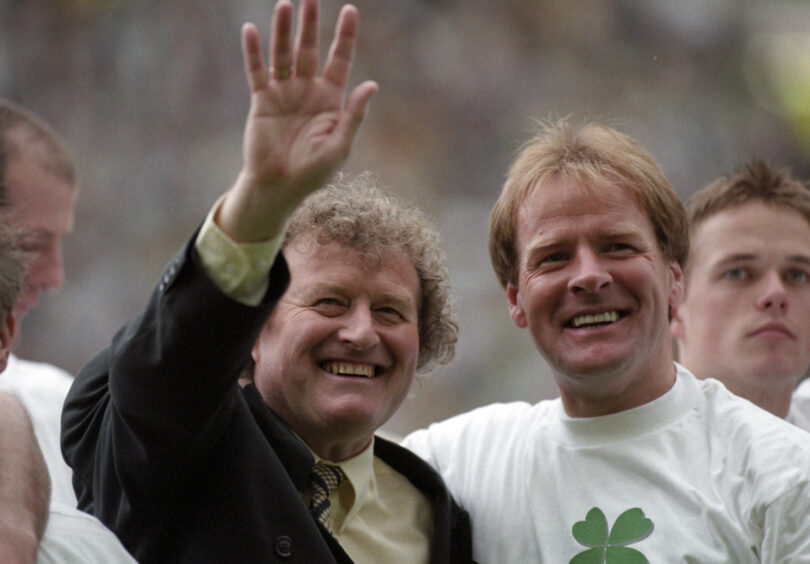
It didn’t register on football’s Richter Scale at the time. But 25 years ago tomorrow, Celtic completed arguably the best piece of transfer business in their history.
Manager Wim Jansen paid £650,000 to bring Sweden forward, Henrik Larsson, to Scotland from Feyenoord.
Former Celtic, Borussia Dortmund, Hibs and Scotland midfielder Murdo MacLeod was Jansen’s No. 2 at the time.
So he had a front-row seat as the dreadlocked striker established himself as the club’s most-influential player since Kenny Dalglish had left for Liverpool 20 years earlier.
In his first season in Glasgow, Celtic won the League Cup (with Larsson scoring in the Final against Dundee United) and, more importantly, pipped Rangers for the title on the final day of the campaign to prevent 10-in-a-Row.
Larsson was the club’s leading marksman with 19 goals, a figure he would more than double in three of the next six seasons.
He amassed 242 goals in 313 games for the Hoops, and would have claimed even more if he hadn’t sustained a broken leg against Lyon in October, 1999 which sidelined him for seven months.
MacLeod has no doubt that Larsson was the biggest bargain buy Scottish football has seen.
“Celtic have made some great signings over the years, but it’s hard to think of anyone who was better than Henrik,” he said.
“Everyone still talks about his first game for us, when he played a pass which Chic Charnley intercepted and went on to score the winning goal for Hibs at Easter Road.
“But what about his last match that season? We had to beat St Johnstone on the final day to clinch the title. There were 60,000 fans inside the ground and we were as nervous as they were.
“But Henrik scored a wonder goal after two minutes to settle us, and we went on to win 2-0.
“Of course, although he was a very good player, he wasn’t yet the Henrik Larsson he would become.
“The fact is that every single season, he became better than he’d been the year before, and a lot of that was down to hard graft.
“He was the kind of player who always gave 100% at training, as well as games, which is why he had the career that he had.
“Henrik couldn’t have played at such a high level for so long if he hadn’t shown the right attitude, and looked after himself.
“He also liked his golf, which helped him settle in Scotland. If he’d been flying back and forth to Sweden all the time, then he might have been looking for a move.
“But I remember him telling me early on that he loved living here, and that he intended staying for six or seven years. He was as good as his word.
“When Wim and I left after one season, he could have been forgiven for saying he was off as well. But he had already decided he was happy at Celtic.”
Larsson remains Celtic’s top European goalscorer with 35 goals, and he was coveted by many clubs after his 53 goals in Martin O’Neill’s Treble-winning 2000/01 season won him the Golden Boot.
However, he gave the Hoops the best seven years of his career.
“Even if Celtic managed to find someone as brilliant as Henrik was, they could never persuade him to stay at Parkhead for that length of time nowadays,” MacLeod continued.
“But he always did what he said he would do.
“When he eventually left in 2004 to sign for Barcelona, it was because he wanted to win the Champions League.
“He duly came off the bench to set up both their goals when they beat Arsenal 2-1 in the 2006 Final.
“Henrik then rejoined his hometown team, Helsingborg, but even then he wasn’t finished because Sir Alex Ferguson made him an emergency signing during an injury crisis.
“He helped Manchester United win the title, as well as scoring the only goal in a Champions League win over Lille when he was almost 36.
“Of course, Henrik loved the big occasions – Old Firm games [scoring 15 goals in his 30 derby appearances] European ties, cup finals, international matches, you name it.
“But in spite of the fact he was Celtic’s biggest star, he was never a Billy Big Time. He joined in with the rest of the lads at nights out and in the dressing room.
“He could hit the heights, but he was always down to earth.”

Enjoy the convenience of having The Sunday Post delivered as a digital ePaper straight to your smartphone, tablet or computer.
Subscribe for only £5.49 a month and enjoy all the benefits of the printed paper as a digital replica.
Subscribe